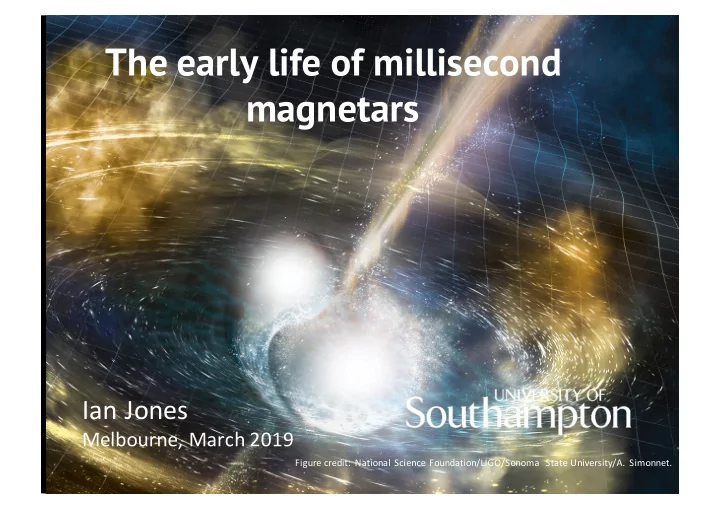

The early life of millisecond magnetars Ian Jones Melbourne, March 2019 Figure credit: National Science Foundation/LIGO/Sonoma State University/A. Simonnet.
Leon Mestel: 1927 – 2017 Pioneer in the modelling of stellar magnetic fields. Developed model for precessing magnetic star. 2
What happens to spin and magnetic axes in early life of a pulsar? Relevant for: 1. Gravitational wave emission following birth. 2. Light curves of short GRBs, maybe! 3. Determining the inclination angle of the observed pulsar population. Based on: • Lander & DIJ MNRAS 456 4343 (2017) • Lander & DIJ MNRAS 481 4169 (2018) 3
Millisecond magnetar birth Will assume stars are born: 1. Spinning fast 2. With strong magnetic field Rotation may itself wind-up the magnetic field. Could get a strong internal toroidal magnetic field. Poloidal Toroidal 4 Figure credit: J. J. Love
Magnetic distortions Poloidal field Toroidal field Oblate distortion Prolate distortion 5
Basic picture Magnetic field distorts star, giving ellipticity: Unless rotation and magnetic axes exactly aligned, star will then undergo free precession. Free precession consists of rapid spin of magnetic axis about fixed angular momentum axis… …plus slow superimposed rotation about magnetic axis. 6
Geometry of the precession 𝐾 = angular momentum Angular momentum vector 𝑛 = magnetic axis fixed in space. Angle 𝜓 Magnetic deformation assumed axisymmetric about axis 𝑛 . ⟹ biaxial free precession. [We consider early stages, before crust formation.] Centrifugal distortion not shown in picture! 𝜓 = 0 ∶ no gravitational wave emission 𝜓 = ) * : optimal gravitational wave emission 7
Spin-flip mechanism Pointed out by P. B. Jones (1976) Mestel+ (1981). Kinetic energy of a rigid precessing biaxial body: 𝐹 = 𝐾 * 1 − 𝜗 3 cos * 𝜓 2𝐽 / If one allows for internal dissipation, 𝐹̇ < 0, 𝐾̇ = 0 , so: • Oblate: 𝜗 3 > 0, 𝜓̇ < 0, ⇒ 𝑏𝑚𝑗𝑜𝑛𝑓𝑜𝑢 • Prolate: 𝜗 3 < 0, 𝜓̇ > 0, ⇒ 𝑝𝑠𝑢ℎ𝑝𝑝𝑜𝑏𝑚𝑗𝑡𝑏𝑢𝑗𝑝𝑜 Cutler (2002): Prolateoptimal for gravitational wave emission 8
Magnetic torques Magnetic torques cause spin-down. They also tend to make 𝜓 decrease (Davis & Goldstein 1970, Michel & Goldwire 1970, Goldreich 1970). Can therefore get competition between: ORTHOGONALISATION ALIGNMENT Due to internal dissipation Due to electromagnetic in prolate star torques. 9
Internal dissipation: Non-rigid response Spin axis traces out a cone of half-angle 𝜓 as viewed from rotating star. But spin axis defines centrifugal bulge, of size: ⟹ have density wave propagating around star 10
Non-rigid response: “xi-motions” Time-varying density perturbation will induce displacement motion in the stellar fluid, Mestel’s “xi-motions”. Crucial for calculating dissipation rates (e.g. due to shear & bulk viscosities), and hence evolution in wobble angle. Must satisfy continuity equation: But this isn’t sufficient to compute 𝜊 . 11
Solution: Lander & DIJ 2017 Take full set of PDEs, and exploit smallness of 𝜗 H and 𝜗 3 : Zeroth order: spherical star • Order 𝜗 H : rotational deformed star • Order 𝜗 3 : magnetically deformed star • Order 𝜗 H 𝜗 3 : xi-motions! • 12
Application: newly born NSs Imagine NS born with some non-zero inclination angle. Set of coupled ODEs (Lander & DIJ 2018): Temperature: IJ IK = −𝑜𝑓𝑣𝑢𝑠𝑗𝑜𝑝 𝑑𝑝𝑝𝑚𝑗𝑜 Spin frequency: IH IK = −𝐹𝑁 𝑡𝑞𝑗𝑜𝑒𝑝𝑥𝑜 Inclination angle: IR IK = ±𝑤𝑗𝑡𝑑𝑝𝑣𝑡 𝑒𝑗𝑡𝑡𝑗𝑞𝑏𝑢𝑗𝑝𝑜 − 𝐹𝑁 𝑏𝑚𝑗𝑜𝑛𝑓𝑜𝑢 Oblate ( 𝜗 3 > 0): alignment Prolate ( 𝜗 3 < 0): counteralignment, aka “Mestel-Jones spin-flip” 13
Inter-dependence of parameters Dominant viscous damping mechanism is probably bulk viscosity. Bulk viscosity frequency dependent (Lindblom & Owen 2002): 𝜐 ~ 𝑈 YZ , microphysical reaction rate 𝜕 ~ 𝑔𝜗 3 ~ 𝑔𝐶 * , precession frequency Complex interplay EM torque ~𝑔 ^ 𝐶 * 14
“Orthogonalisation” curve Can use back-of-the-envelope formulae to estimate curve in (𝑔, 𝑈) plane above which spin-flip active: 2 1a 3a 1b 3b B = 10 16 G 15
Time evolutions Time evolutions of coupled ODEs show rich structure. Can classify as Aligned, Orthogonalised, or Unevolved. Figure: Lander & DIJ (2018) 16
Current work: improving torque model Actual EM torques on millisecond magnetars more complex. Need to account for angular momentum transport by outward matter flux. Bulk viscosity may be suppressed in very young (hot) stars, and also in older (cooler) stars. Currently under investigation. 17
Summary • Newly born millisecond magnetar may be susceptible to spin-flip instability. • Depends upon competition between electromagnetic torques and internal dissipation. • Important for pulsar physics and GW emission. • Stand to learn about both interior and exterior of star. 18
Recommend
More recommend